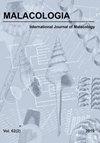Redescription of the Sea Hare Phyllaplysia viridis (Bergh, 1905) (Gastropoda: Heterobranchia: Aplysiida)
IF 1
4区 生物学
Q4 ZOOLOGY
引用次数: 0
Abstract
ABSTRACT The small, green sea hare, Phyllaplysia viridis, originally described from Indonesia in 1905, has rarely been recorded since. Because the taxonomic status of Phyllaplysia is uncertain, there remains a need for clarification of the currently accepted species. To do so, we used contemporary specimens from eastern Australia and Indonesia to redescribe P. viridis using photographs and scanning electron imagery of its external and internal morphology. Although all examined specimens were small, consistently green animals, images revealed some variation in colour and pattern among adults. Molecular data confirmed the presence of P. viridis in the Philippines, Indonesia and eastern Australia. A phylogenetic tree based on available COI barcode sequences illustrate a sister relationship with other Phyllaplysia. The construction of a haplotype network failed to show any marked geographic structure among specimens.海兔Phyllaplysia viridis (Bergh, 1905)的再描述(腹足目:异鳃目:海兔目)
小型绿海兔(Phyllaplysia viridis)最初于1905年在印度尼西亚被发现,此后很少有记录。由于叶根属植物的分类学地位尚不确定,目前已被认可的种类仍需进一步澄清。为了做到这一点,我们使用来自澳大利亚东部和印度尼西亚的当代标本,使用照片和扫描电子图像对其外部和内部形态进行了重新描述。虽然所有被检查的标本都是小的,一直是绿色的,但图像显示,成年动物的颜色和图案有所不同。分子数据证实在菲律宾、印度尼西亚和澳大利亚东部存在病毒疟原虫。基于现有COI条形码序列的系统发育树说明了与其他叶根属植物的姐妹关系。单倍型网络的构建未能显示出标本间任何明显的地理结构。
本文章由计算机程序翻译,如有差异,请以英文原文为准。
求助全文
约1分钟内获得全文
求助全文
来源期刊

Malacologia
生物-动物学
CiteScore
2.00
自引率
0.00%
发文量
15
审稿时长
3 months
期刊介绍:
Malacologia publishes papers on all groups of the Mollusca. Malacologia specializes in publishing long papers and monographic treatments. Complete data are especially appreciated. Papers must be of interest to an international readership. Papers in systematics, ecology, population ecology, genetics, molecular genetics, evolution and phylogenetic treatments are especially welcomed. Also welcomed are letters to the editor involving papers published or issues of import to science of the day.
 求助内容:
求助内容: 应助结果提醒方式:
应助结果提醒方式:


